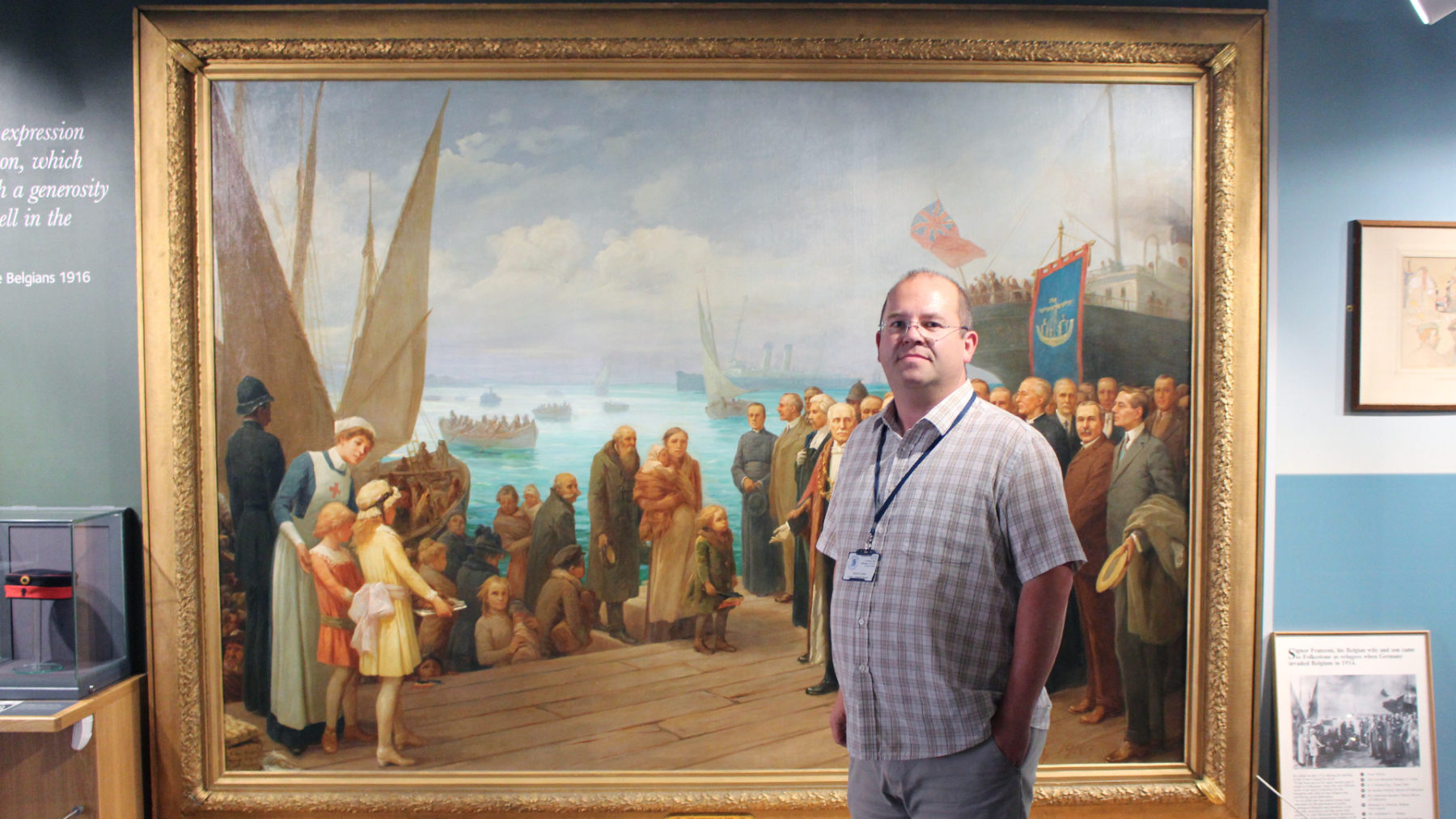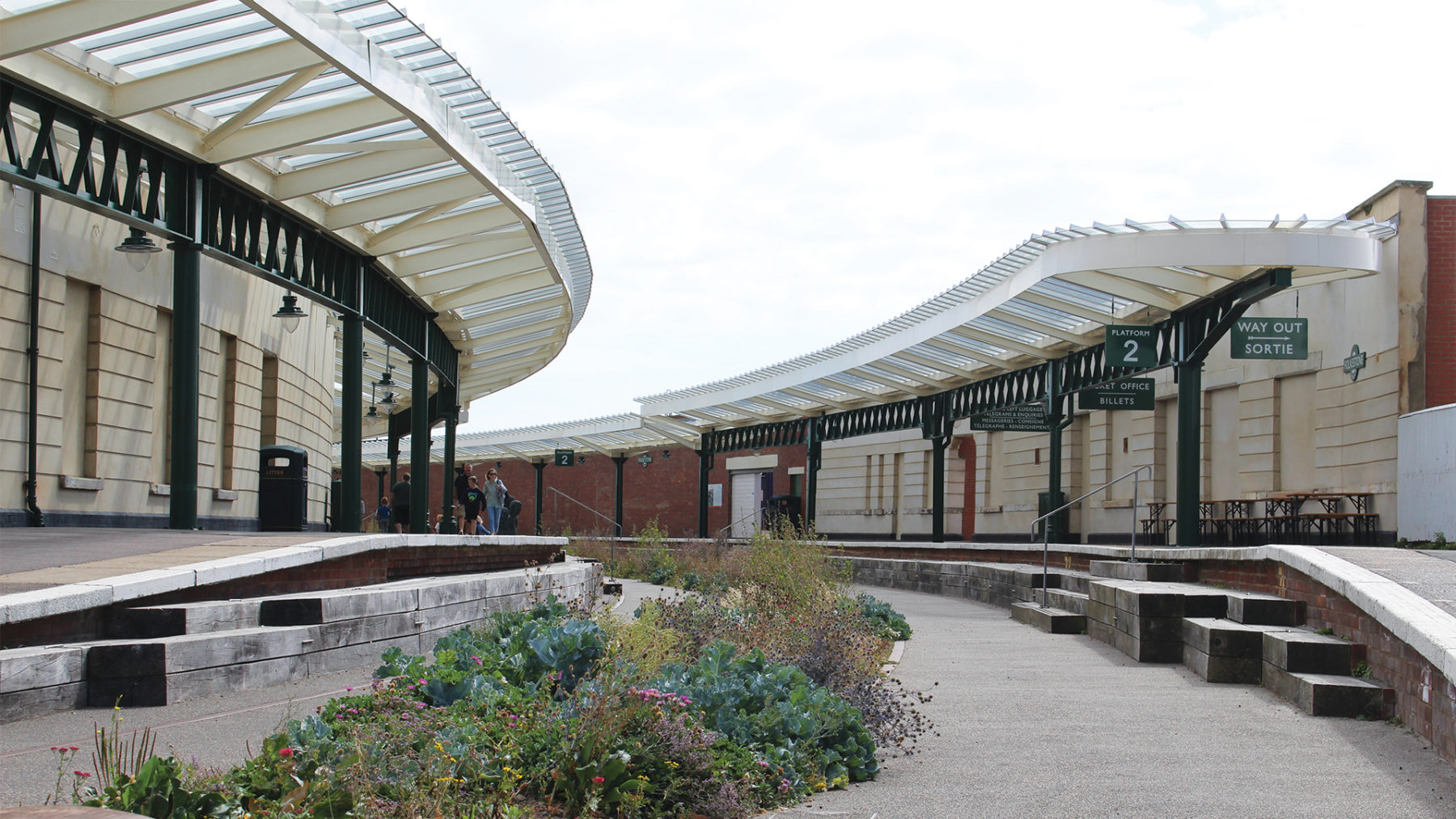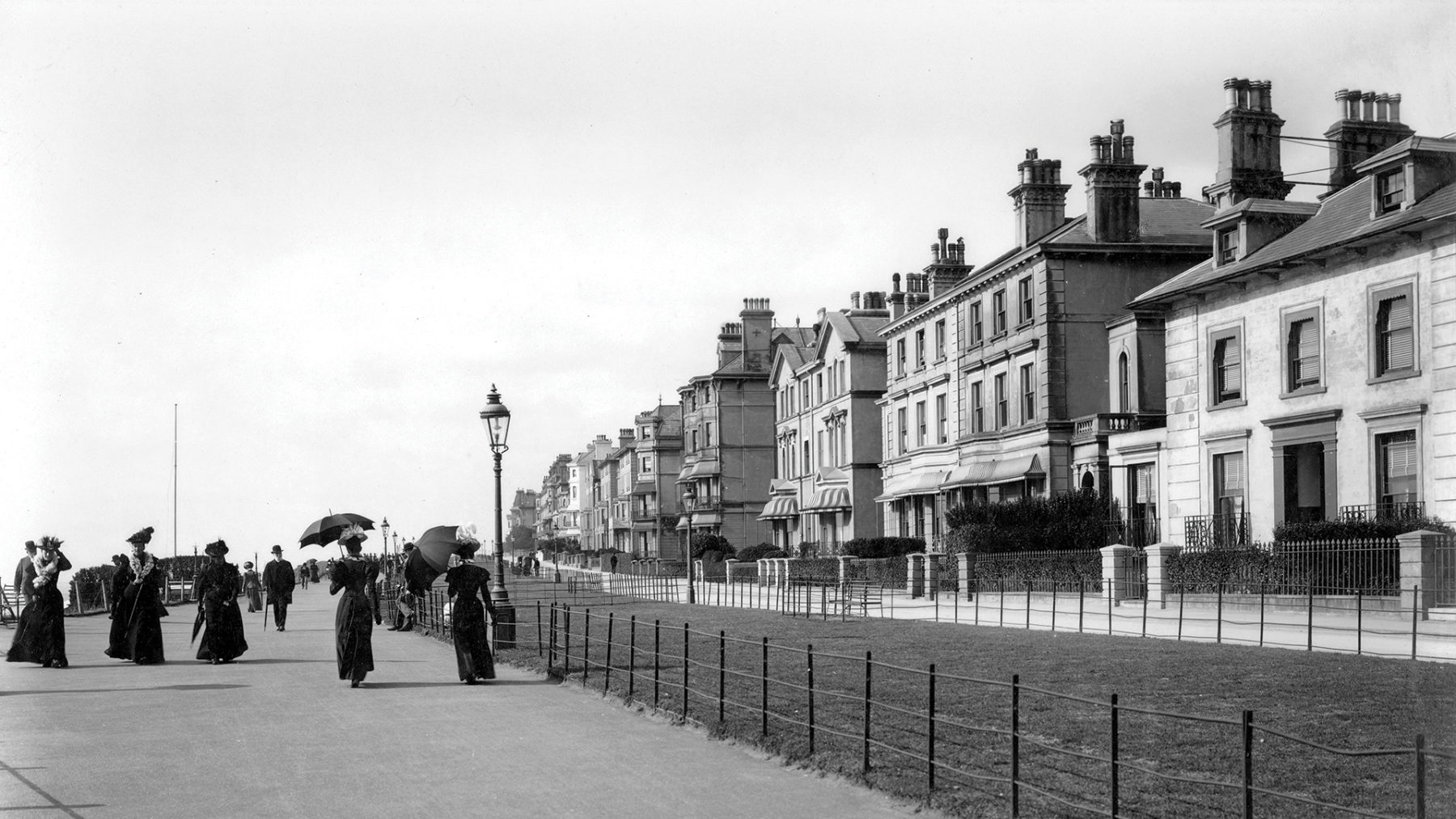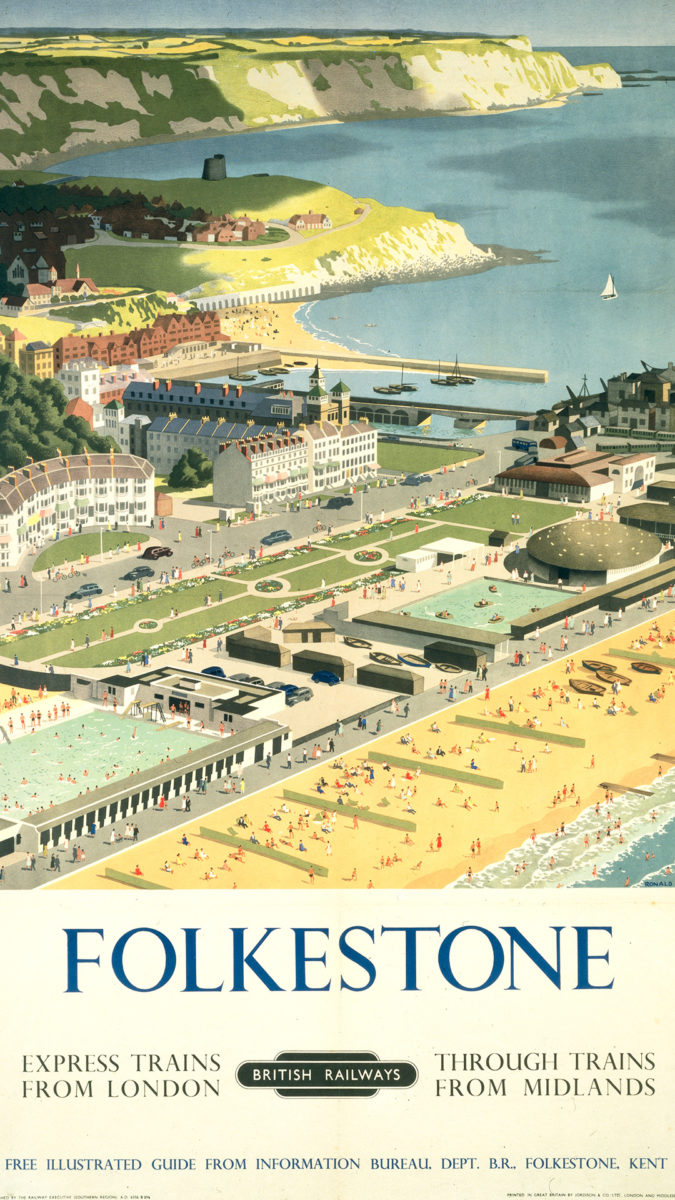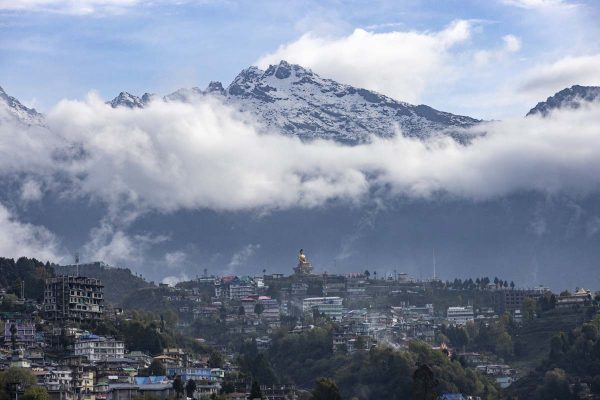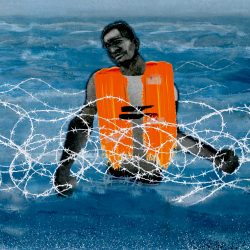Coda Story / Google, c 2021 CNES / Astrium, Maxar Technologies
Refugee crossings and anti-immigrant sentiment spark a historical reckoning in an English seaside town
The cliffs have eyes in Kent, a coastal county in the south of England. Some anxiously watch the horizon to ensure that fragile inflatable dinghies, overloaded with refugees, are picked up by the U.K. Border Force and escorted to safety. Others record footage of the arrivals to post on right-wing social media channels and drum up anti-immigrant hysteria.
One day in July, Darran Cowd stood high above the town of Ramsgate, watching a Royal National Lifeboat Institution vessel make land.
“Our lifeboat brought in a group of refugees that were stranded at sea,” he said, tearing up at the memory. “I was so proud of my friends, bringing those people to safety.”
Soon after, the British far-right activist Nigel Farage posted a picture of the same vessel on Twitter, with a very different sentiment.
“Sadly the wonderful RNLI in Kent has become a taxi service for illegal immigration,” he wrote, sparking predictable howls of online outrage. A number of social media users attacked the RNLI — a registered charity, largely staffed by volunteers — pledging never to donate to it again.
That one episode sums up the tensions roiling this once proudly cosmopolitan, seafaring part of the United Kingdom. The ideological battle between groups and individuals who feel an obligation to welcome people fleeing war, poverty and persecution, and others who believe that the U.K. is being overrun with undeserving economic migrants, also reflects a wider post-Brexit mood, as the country seeks to redefine its role in the world.
On Tuesday September 7, it was reported that record 1,000 people tried to cross the English Channel. Two days later, news broke that Home Secretary Priti Patel had sanctioned the Border Force to intercept and “push back” vessels attempting to bring migrants across. The United Nations High Commissioner for Refugees has argued that such tactics violate international law. Experts say they force people to use longer and more dangerous routes.
In response to questions about the legality of this approach, a Home Office spokesperson simply wrote: “We do not routinely comment on maritime operational activity.”
In Folkestone, boats packed with people have been arriving from France every few days. The town has become a focal point for anti-migrant campaigners. But people like Darran Cowd believe that its long and robust history of offering safe harbor to the vulnerable still offers a solid foundation for the future.
Cowd is a curator at Folkestone Museum. There, a large painting hangs on the wall. Made during World War I, it shows local people standing at a dock, welcoming a crowd of Belgian refugees. A seemingly endless succession of silhouetted boats fades into the horizon.
In 1914, up to 16,000 Belgians arrived in Folkestone in a single day, fleeing German invasion. The painter, an Italian named Fredo Franzoni, was a refugee himself, who fled Belgium with his family. He gave the picture, composed from memory, to the town in 1916.
Local resident Jonny Wicken, 43, has known the painting nearly all his life. The week the Taliban took over Kabul, he visited the museum and looked at it again.
“I wanted to go and see it to really think about how we were welcoming people,” he said, while walking along the harbor. “I looked at those people for the first time properly, I think. I looked at their faces and I really felt that they were stepping out of that picture.”
Wicken posted a photograph of the artwork to the 17,000-strong town resident page on Facebook. “Surely this is one of Folkestone’s proudest moments,” he wrote. “We’ve done it before and this painting shows us we can make #refugeeswelcome again.” The post attracted hundreds of likes, but also many negative comments. “Belgian culture did not want to destroy ours,” wrote one user. “Every soul deserves the chance to live and the people saying we shouldn’t help are just as bad as the Taliban,” retorted another.
Folkestone is a fractured place, caught between its former identity as an outward-looking port community with strong links to Europe, its proud military history and its present-day reality.
The town thrived in the years following World War II. Its typically English seafront featured funfair rides and arcades, and the wider area boasted a flourishing tourism industry. Regular passenger ferries between Folkestone and Boulogne also made it an important international hub.
As cheap air travel began to boom in the mid-20th century, making overseas vacations affordable for large numbers of British people, seaside towns across the U.K. edged into a long and steep decline. Folkestone was no exception.
The May 1994 opening of the Channel Tunnel, which links England to France by rail, was accompanied by promises of a renewed economy and a vibrant “Europeanization” of the area. Neither materialized. The mouth of the tunnel exists solely as an entry and exit point for cars boarding intercontinental trains, and many of the ferry services that operated from Folkestone moved to nearby Dover and Ramsgate. In 2000, the last ferry between Folkestone and Boulogne sailed and, for the first time in its history, the harbor was no longer a cross-channel port.
Now, the only meaningful connection between Europe and Folkestone’s people are the migrant dinghies.
Wicken, who spent his teenage years taking cheap trips to France on weekends, believes that if the ferries still ran, some residents might be less hostile towards the new arrivals. “You’re eroding those links to places outside of where you are,” he said. He also recalled how the Folkestone of his youth had a more “European vibe,” a sense of openness, and links to other cultures. “We don’t have the same connection to the sea anymore.”
Recording footage of migrants arriving on the Kent coast has become something of a sport for right-wing activists. The videos are often picked up and reposted by figures such as Farage, or accounts such as Leave.EU, a pro-Brexit organization funded by the businessman and political donor Arron Banks. They invariably attract thousands of views and incensed comments. In a recent thread, one Facebook user wrote: “We need to sit on the beach with a .22 rifle and shoot the boats down.”
Before the dinghies began bringing people over, refugees from Calais attempted to arrive in Folkestone by stowing away in lorries and trains entering the Channel Tunnel. Many died trying to jump onto passing trains, or were crushed by trucks or electrocuted inside the tunnel.
In July 2015, 22-year-old Husham Osman Alzubair, from Sudan, was found dead with severe head injuries on a freight train that had arrived in Folkestone from Calais. That same year, police had to break up clashes between rival protesters when the far-right Britain First and English Defence League stood against a collective known as Folkestone United, which was demanding an end to the tunnel deaths.
Over the past decade, affluent Londoners in search of sea air and comparatively cheap period housing have decamped to the Kent coast, transforming places like Margate from rundown resorts to artsy destinations, frequented by celebrities and fashionable young people. Signs of similar change are visible in Folkestone, too.
Sandgate is filling up with metropolitan incomers, attracted by the neighborhood’s bracing sea views and high-performing schools. The arts charity Creative Folkestone has peppered the town center with colorful installations for its 2021 Triennial, and transformed some of Folkestone’s historic streets into what it describes as an “urban village of designers, filmmakers, musicians, web developers and artists.” But a short walk away are the harbor and the eastern side of town — two of the most deprived neighborhoods in Kent. Folkestone’s unemployment rate is also above the national average.
“People are feeling a bit pushed out of their town,” said Wicken. “Meanwhile, people are arriving on those beaches, and you can see the hate directed at them.”
When Kabul fell to the Taliban, Farage immediately connected the crisis to migrants arriving in places like Folkestone. “You can now see a wave of people fleeing Afghanistan, and we already have numbers we quite simply can’t cope with,” he said recently on GB News, a new British right-wing TV channel.
False claims that 48,000 asylum seekers were living in luxury hotels proliferated online at the height of the coronavirus pandemic. The truth is that around 1,000 migrants are temporarily housed in hotels each night. All the same, Farage remains happy to jump on this narrative.
“The four-star hotels are booked, they’re running out of private accommodation. When we used the Napier barracks in Folkestone it was good enough for the British army, but deemed not to be good enough for those that have illegally come to this country. So the Afghan thing is going to play into this in a big way,” he said on the news show in August.

At the edge of town, in Sandgate, lies Napier Barracks. The military-owned site, once a staging post for troops on their way to fight in the trenches of Northern France during the First World War, was repurposed last year as a center to house up to 400 men while their asylum claims are processed.
The compound has been fraught with controversy ever since. In January, a major outbreak at the camp led to almost 200 residents catching coronavirus. Far-right protesters have picketed it and 16 racist incidents have been reported to the Home Office since it opened. In June, a High Court judge ruled that conditions inside did not meet adequate health standards and that the home secretary had acted “irrationally” in housing people there.
“People talk about Napier Barracks as if it’s just this site up the road that we have to drive past,” said Cowd.
Anti-immigration YouTubers, however, have paid an uncomfortable amount of attention to the facility, filming outside the gates, flying drones over it and recording the residents.
I arrived there as the sun was beginning to set. Ring-fenced with blue sacking, its grim barbed wire has recently been removed. Residents must sign in and out, are given three meals a day, issued £8 ($11) a week and not allowed to work.
A group of young men were playing football on the grass outside. Yonas, 33, originally from Eritrea, spoke to me on condition that I refer to him using a pseudonym. When he arrived in Dover in June, he was transferred to a hotel in London. Then, a month ago, he was loaded onto a minibus. When he asked the bus driver where he and the other passengers were going, the driver said that he didn’t know. Yonas watched nervously on his phone as the GPS showed that they were headed towards Dover.
“We thought, ‘Are we going back to France?” he said.
Instead, they were taken to the barracks.
“This is a prison,” he added. “I don’t want to be in a prison. I’ve come here to change my life.”
On one of his first days in Folkestone, Yonas and a friend were walking around on the quiet, residential streets nearby. They crossed the road at a red traffic light. He told me that rather than slowing down, the driver sped up towards them.
“He held up a finger to me,” Yonas said.
“People say, ‘Fuck you.’ They don’t like us,” another friend added. “I feel they think I am coming to make a problem for them.”
There have been some good moments, though. Yonas recalled how during the warm weather, he and some friends went to the beach to swim. “People were friendly,” he said.
Despite repeated calls for the closure of Napier Barracks, the Home Office recently advised Folkestone & Hythe District Council that it intended to keep the compound open until 2025. Councillor Jenny Hollingsbee said the local authority had no role in the decision.
“This is very disappointing news and not what we had been hoping to hear,” she said in a statement. “I have made it clear to the Home Office that if the use is to continue, then it is our expectation that the government will make further investment to improve facilities for those staying at the barracks.”
Meanwhile, Cowd, the curator at Folkestone Museum, has been searching for a new centerpiece for Folkestone Museum’s collection: a lifejacket from one of the arriving dinghies.
“You can tell a whole host of stories about the refugee experience with that one item,” he said. “I think that, right now, we’re too close to events to be able to display it, but one day, after we’ve had a bit of thinking time, we might be able to actually look back.”
The story you just read is a small piece of a complex and an ever-changing storyline that Coda covers relentlessly and with singular focus. But we can’t do it without your help. Show your support for journalism that stays on the story by becoming a member today. Coda Story is a 501(c)3 U.S. non-profit. Your contribution to Coda Story is tax deductible.




